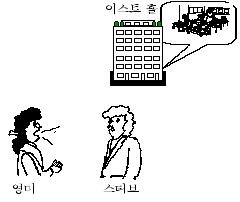
| G5.1 Location particles:
�� vs. ����
����־��? ��� ������? ���(��)�� . . .�����? _____���־��. _____������. _____���������. |
Examples
| Location of existence: static location | |||
| (1) | ����: | ���� �б� �Ĵ��� ��� �־��? | |
| ����: | ���Ͽ� ������ �־��. | ||
| (2) | ����: | ���� ��ϴ� ��� �輼��? | |
| ����: | �������� �־��. | ||
| (3) | ������: | ��Ƽ��, �ѱ��� å ��� �־��? |  |
| ��Ƽ��: | ���� ���� �־��. | ||
Destination/goal location |
|||
| (4) | ��Ƽ��: | ���̾� ��� ������? |  |
| ����: | �������� ����. |
||
| ��Ƽ��: | ��ȭ���� ����. | ||
Location of activities: dynamic location |
|||
| (5) | A: | �ѱ��� ���� ���(��)�� �ؿ�? |  |
| B: | �̽�Ʈ Ȧ���� �ؿ�. | ||
| A: | �������� �ؿ� | ||
| B: | 2������ �ؿ�. | ||
| (6) | A: | ���ϼ��� ���(��)�� ���? | |
| B: | ��ȭ������ ���. | ||
Notes
[���� 1] Answer each question according to the given picture.
����:
 |
A: | ���(��)�� �����ؿ�? |
| B: | ���������� �����ؿ�. |


| (1) | ����: | ���� ��� ������? |
| ��Ƽ��: | �ѱ��� ������ ����. | |
| (2) | ����: | �ѱ��� ������ ��� �ؿ�? |
| ��Ƽ��: | �̽�Ʈ Ȧ���� �ؿ�. | |
| (3) | ����: | �ѱ��� ������ �� ���� �־��? |
| ��Ƽ��: | 2���� �־��. | |
| (4) | ����: | ���(��)�� �����ϼ���? |
| ��Ƽ��: | ������ ������ �ؿ�. | |
| (5) | ����: | ���� ��� �־��? |
| ��Ƽ��: | �߷�Ÿ�� Ȧ�� �־��. |
[���� 2] Exchange conversation regarding the following questions, as in the example.
����:
| ��Ƽ��: | ����, ��� �����ؿ�? |
| ����: | ���� ���������� �����ؿ�. ��Ƽ�꾾�� ��� �����ؿ�? |
| ��Ƽ��: | ���� ������ �����ؿ�. |
(1) ��� �����ؿ�?
(2) ��� ����
�Ծ��?
(4) ���
�ѱ��� �����ؿ�?